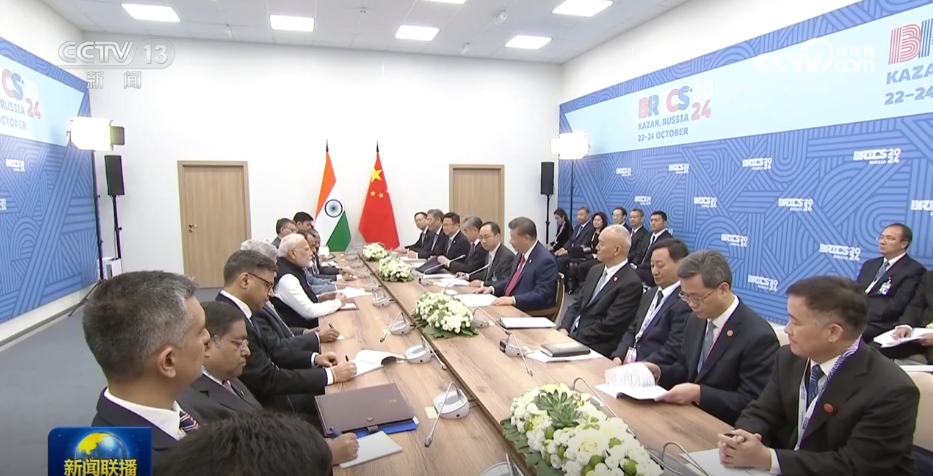Eric's Insight: Yunnan to usher in more visitors, traders from India
A group of north Indian musicians recently visited Yunnan province, kicking off a new round of people-to-people exchanges between China and South Asia. As the China-India military standoff thaws in the border areas and the national leaders meet at the 2024 BRICS summit in Russia, Yunnan will be appealing to more tourists and traders from India.

President Xi Jinping meets with Indian Prime Minister Narendra Modi in Kazan, Russia, on the sidelines of the 16th BRICS Summit.
First, Yunnan has its own unique features to forge people-to-people ties with Indian states. Geographically, Yunnan sits close to the north and northeast Indian regions, and the distance between Nagaland and Nujiang prefecture is just some 200km. At a broader level, Yunnan and India are linked up by the mighty Himalaya. India lies south of the Himalaya, while Yunnan sits southeast of the Himalaya. Put it in another way, Yunnan and India are only a mountain away and Yunnan can be easily accessed by Indian travelers.
Culturally, Yunnan is open and inclusive, and it is home to diverse religious believers, where Buddhists and Islamists live in harmony and happiness. They even belong to the same family. Among Buddhists, the Hinayana believers mostly live in Dehong, Lincang and Xishuangbanna, the Tibetan Buddhists mostly practice in Diqing, while the Mahayana believers inhabit across Yunnan. But overall, they believe that Buddhism originates in north India.

A group of north Indian musicians recently visit Yunnan province.
Back to the Tang Dynasty (618-907), Chinese monk Tang Sanzang went on a long journey to today’s India and its surrounding regions to acquire the classic Buddhist scriptures, and the story was later rendered into the classic Chinese novel Journey to the West, where the monk's disciple is Su Wukong, or the Monkey King. Nowadays the Black Myth of Wukong is loved by global online gamers, and it’s largely a Buddhist story based on the novel, with quite a few scenes in the game taken from Yunnan scenic areas. As the Wukong game gets increasingly popular, Yunnan will undoubtedly be more inviting to Indian teenagers.
Ethnically, Yunnan is linked to India by the cross-border ethnic groups such as the Dai and Tibetan folks. Some four million Tai folks live in the Indian state of Assam, and some 120 thousand Tibetans live in regions across India. The Indian Tai people are akin to the Dai ethnic group in west Yunnan’s Dehong and Xishuangbanna, while the Indian Tibetans are similar to their peers in northwest Yunnan’s Diqing prefecture in customs, making the Yunnan-Indian cultural exchanges more natural.

The Indian pavilion is packed with visitors at the 2023 China-South Asia Exposition in Yunnan.
Second, the thawing tension in the China-India border areas and the changing international landscape will make the two countries get closer, and thus more Indian business persons will be engaged with their Yunnan peers for shared prosperity. Yunnan is the permanent host province of the China-South Asia Expo, and it also has other platforms for bilateral economic cooperation, like the annual China-South Asia Cooperation Forum and the China-South Asia Business Forum. These mechanisms allow Yunnan to play a more positive role in China-India economic cooperation.
China has never taken India as a rival, and the two countries are natural partners as pillars of the Global South. It is the US who is fanning flames across the world. To sow discords between China and its neighbors, the US has been paying lip services to south-southeast Asian countries, as is pointed out by an Opinion piece recently posted on India Today’s website. “The US factor as a key geopolitical instrument for India’s China challenge has not quite fulfilled the promise over the past decade. Even after 2020, the idea that the Ladakh crisis would open unprecedented economic and geopolitical opportunities to broaden the partnership with the US did not occur.”

An Indian business lady displays goods at the 2023 China-South Asia Exposition in Yunnan.
What’s more, the outbreak of multipolarity has thrown all previous Indian calculations by the wayside. Since the Ukraine conflict, US global geostrategy has shifted to Eurasian containment. Even in the Indo-Pacific, the US has doubled down on its core alliance partners in East Asia, with India’s role becoming a more peripheral one insofar as core regional and continent-wide security questions are concerned. The changing world order offers a fresh opportunity to restore China-India relations.
Despite some irrational restrictive measures that India imposed on Chinese businesses over the past years, the China-India trading ties remained strong. In the first three quarters of 2024, the total trade volume between China and India was 739.5 billion yuan, up 4.2% year on year. Partly because of the China-South Asia cooperation mechanisms, Yunnan has, in the past decade, doubled its trade with the south Asian countries, including India. With the progress in China-India relations, Yunnan will surely usher in more Indian traders.
Writing by Wang Shixue; Photos by CCTV and Yunnan Daily; Proofreading by Zu Hongbing and Wang Huan